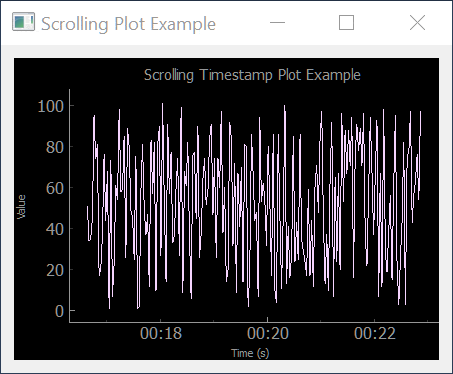
我不确定你想要实现什么,因为你的代码无法运行,但是看起来你正在尝试创建一个时间戳图。这是一个使用TimeAxisItem跟踪X轴经过时间的小部件。
PyQt5
from PyQt5 import QtCore, QtGui, QtWidgets
from threading import Thread
from collections import deque
import pyqtgraph as pg
import numpy as np
import random
import sys
import time
"""Scrolling Timestamp Plot Widget Example"""
class TimeAxisItem(pg.AxisItem):
"""Internal timestamp for x-axis"""
def __init__(self, *args, **kwargs):
super(TimeAxisItem, self).__init__(*args, **kwargs)
def tickStrings(self, values, scale, spacing):
"""Function overloading the weak default version to provide timestamp"""
return [QtCore.QTime().currentTime().addMSecs(value).toString('mm:ss') for value in values]
class ScrollingTimestampPlot(QtGui.QWidget):
"""Scrolling plot widget with timestamp on x-axis and dynamic y-axis"""
def __init__(self, parent=None):
super(ScrollingTimestampPlot, self).__init__(parent)
self.timestamp = QtCore.QTime()
self.timestamp.start()
self.FREQUENCY = 0.025
self.SCROLLING_TIMESTAMP_PLOT_REFRESH_RATE = self.FREQUENCY * 1000
self.DATA_POINTS_TO_DISPLAY = 200
self.data = deque(maxlen=self.DATA_POINTS_TO_DISPLAY)
self.scrolling_timestamp_plot_widget = pg.PlotWidget(axisItems={'bottom': TimeAxisItem(orientation='bottom')})
self.scrolling_timestamp_plot_widget.plotItem.setMouseEnabled(x=False, y=False)
self.scrolling_timestamp_plot_widget.setTitle('Scrolling Timestamp Plot Example')
self.scrolling_timestamp_plot_widget.setLabel('left', 'Value')
self.scrolling_timestamp_plot_widget.setLabel('bottom', 'Time (s)')
self.scrolling_timestamp_plot = self.scrolling_timestamp_plot_widget.plot()
self.scrolling_timestamp_plot.setPen(246,212,255)
self.layout = QtGui.QGridLayout()
self.layout.addWidget(self.scrolling_timestamp_plot_widget)
self.read_position_thread()
self.start()
def start(self):
"""Update plot"""
self.position_update_timer = QtCore.QTimer()
self.position_update_timer.timeout.connect(self.plot_updater)
self.position_update_timer.start(self.get_scrolling_timestamp_plot_refresh_rate())
def read_position_thread(self):
"""Read in data using a thread"""
self.current_position_value = 0
self.position_update_thread = Thread(target=self.read_position, args=())
self.position_update_thread.daemon = True
self.position_update_thread.start()
def read_position(self):
frequency = self.get_scrolling_timestamp_plot_frequency()
while True:
self.current_position_value = random.randint(1,101)
time.sleep(frequency)
def plot_updater(self):
self.data_point = float(self.current_position_value)
self.data.append({'x': self.timestamp.elapsed(), 'y': self.data_point})
self.scrolling_timestamp_plot.setData(x=[item['x'] for item in self.data], y=[item['y'] for item in self.data])
def clear_scrolling_timestamp_plot(self):
self.data.clear()
def get_scrolling_timestamp_plot_frequency(self):
return self.FREQUENCY
def get_scrolling_timestamp_plot_refresh_rate(self):
return self.SCROLLING_TIMESTAMP_PLOT_REFRESH_RATE
def get_scrolling_timestamp_plot_layout(self):
return self.layout
def get_current_position_value(self):
return self.current_position_value
def get_scrolling_timestamp_plot_widget(self):
return self.scrolling_timestamp_plot_widget
if __name__ == '__main__':
app = QtWidgets.QApplication([])
app.setStyle(QtGui.QStyleFactory.create("Cleanlooks"))
mw = QtGui.QMainWindow()
mw.setWindowTitle('Scrolling Plot Example')
scrolling_timestamp_plot_widget = ScrollingTimestampPlot()
cw = QtGui.QWidget()
ml = QtGui.QGridLayout()
cw.setLayout(ml)
mw.setCentralWidget(cw)
ml.addLayout(scrolling_timestamp_plot_widget.get_scrolling_timestamp_plot_layout(),0,0)
mw.show()
if (sys.flags.interactive != 1) or not hasattr(QtCore, 'PYQT_VERSION'):
QtGui.QApplication.instance().exec_()
PyQt4
from PyQt4 import QtCore, QtGui
from threading import Thread
from collections import deque
import pyqtgraph as pg
import numpy as np
import random
import sys
import time
"""Scrolling Timestamp Plot Widget Example"""
class TimeAxisItem(pg.AxisItem):
"""Internal timestamp for x-axis"""
def __init__(self, *args, **kwargs):
super(TimeAxisItem, self).__init__(*args, **kwargs)
def tickStrings(self, values, scale, spacing):
"""Function overloading the weak default version to provide timestamp"""
return [QtCore.QTime().addMSecs(value).toString('mm:ss') for value in values]
class ScrollingTimestampPlot(QtGui.QWidget):
"""Scrolling plot widget with timestamp on x-axis and dynamic y-axis"""
def __init__(self, parent=None):
super(ScrollingTimestampPlot, self).__init__(parent)
self.timestamp = QtCore.QTime()
self.timestamp.start()
self.FREQUENCY = 0.025
self.SCROLLING_TIMESTAMP_PLOT_REFRESH_RATE = self.FREQUENCY * 1000
self.DATA_POINTS_TO_DISPLAY = 200
self.data = deque(maxlen=self.DATA_POINTS_TO_DISPLAY)
self.scrolling_timestamp_plot_widget = pg.PlotWidget(axisItems={'bottom': TimeAxisItem(orientation='bottom')})
self.scrolling_timestamp_plot_widget.plotItem.setMouseEnabled(x=False, y=False)
self.scrolling_timestamp_plot_widget.setTitle('Scrolling Timestamp Plot Example')
self.scrolling_timestamp_plot_widget.setLabel('left', 'Value')
self.scrolling_timestamp_plot_widget.setLabel('bottom', 'Time (s)')
self.scrolling_timestamp_plot = self.scrolling_timestamp_plot_widget.plot()
self.scrolling_timestamp_plot.setPen(246,212,255)
self.layout = QtGui.QGridLayout()
self.layout.addWidget(self.scrolling_timestamp_plot_widget)
self.read_position_thread()
self.start()
def start(self):
"""Update plot"""
self.position_update_timer = QtCore.QTimer()
self.position_update_timer.timeout.connect(self.plot_updater)
self.position_update_timer.start(self.get_scrolling_timestamp_plot_refresh_rate())
def read_position_thread(self):
"""Read in data using a thread"""
self.current_position_value = 0
self.position_update_thread = Thread(target=self.read_position, args=())
self.position_update_thread.daemon = True
self.position_update_thread.start()
def read_position(self):
frequency = self.get_scrolling_timestamp_plot_frequency()
while True:
self.current_position_value = random.randint(1,101)
time.sleep(frequency)
def plot_updater(self):
self.data_point = float(self.current_position_value)
self.data.append({'x': self.timestamp.elapsed(), 'y': self.data_point})
self.scrolling_timestamp_plot.setData(x=[item['x'] for item in self.data], y=[item['y'] for item in self.data])
def clear_scrolling_timestamp_plot(self):
self.data.clear()
def get_scrolling_timestamp_plot_frequency(self):
return self.FREQUENCY
def get_scrolling_timestamp_plot_refresh_rate(self):
return self.SCROLLING_TIMESTAMP_PLOT_REFRESH_RATE
def get_scrolling_timestamp_plot_layout(self):
return self.layout
def get_current_position_value(self):
return self.current_position_value
def get_scrolling_timestamp_plot_widget(self):
return self.scrolling_timestamp_plot_widget
if __name__ == '__main__':
app = QtGui.QApplication([])
app.setStyle(QtGui.QStyleFactory.create("Cleanlooks"))
mw = QtGui.QMainWindow()
mw.setWindowTitle('Scrolling Plot Example')
scrolling_timestamp_plot_widget = ScrollingTimestampPlot()
cw = QtGui.QWidget()
ml = QtGui.QGridLayout()
cw.setLayout(ml)
mw.setCentralWidget(cw)
ml.addLayout(scrolling_timestamp_plot_widget.get_scrolling_timestamp_plot_layout(),0,0)
mw.show()
if (sys.flags.interactive != 1) or not hasattr(QtCore, 'PYQT_VERSION'):
QtGui.QApplication.instance().exec_()
